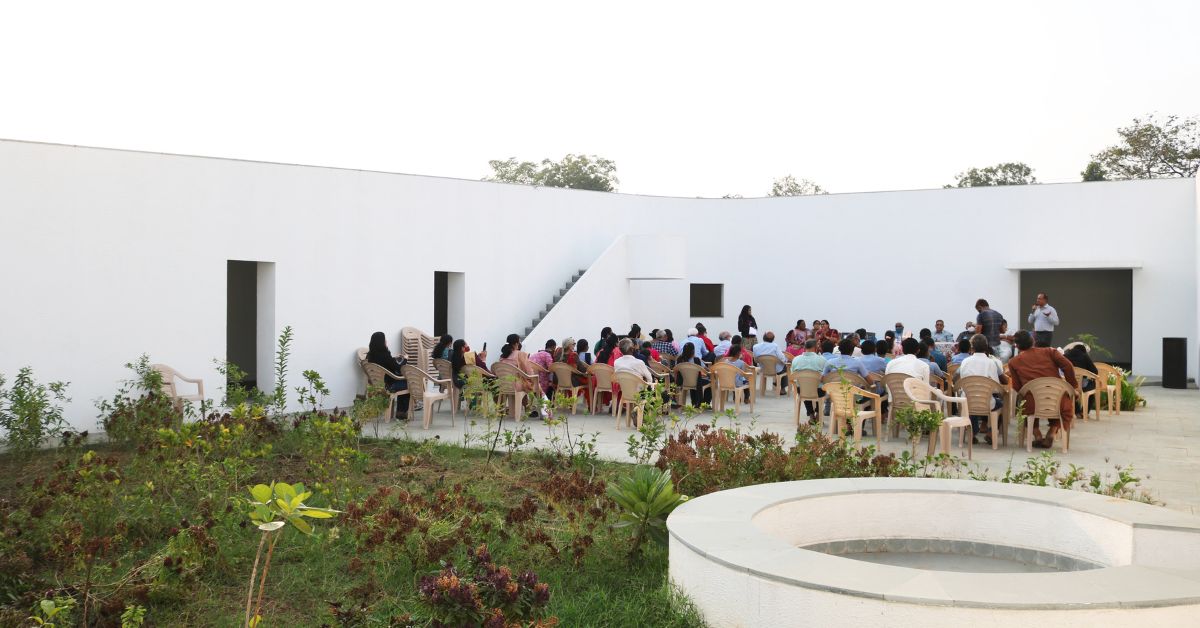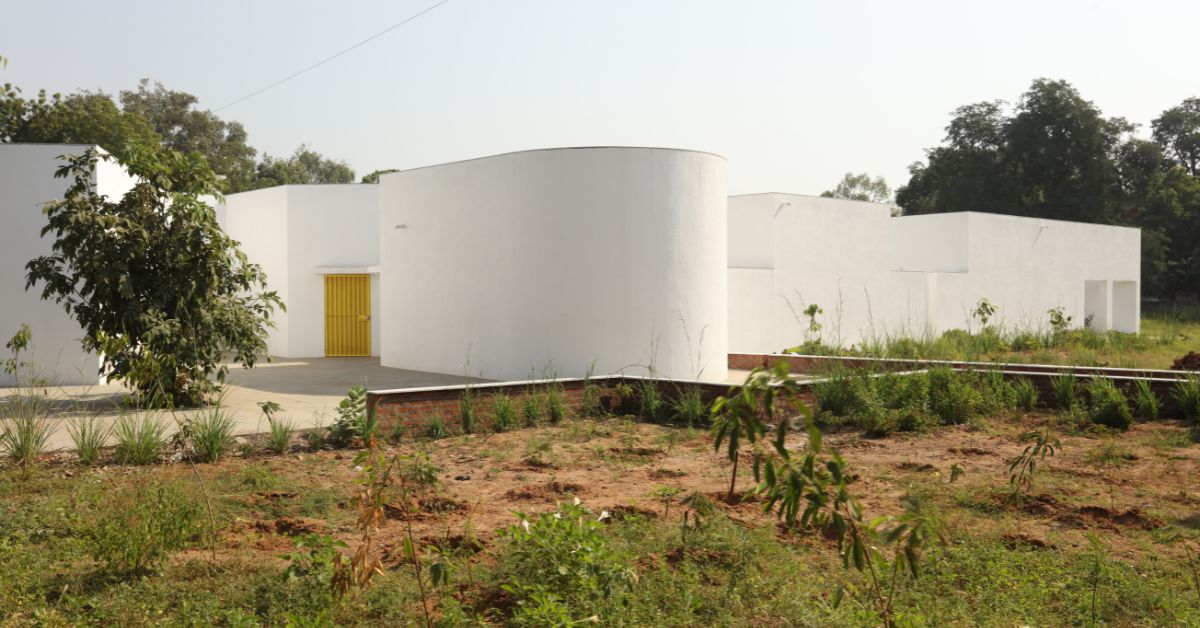This School’s Unique Features Lets Blind Students Navigate Through Smell, Touch & Sound
Located in Gujarat, the 'School for The Blind and the Visually Impaired' is designed especially for children from remote villages of the state. The school's architecture incorporates the senses of smell, touch, hearing, and sight to help its pupils. Anand Sonecha of SEALABS, the creative mind behind this distinctive design, elucidates the concept behind it.

Picture this — a school specifically designed to cater to the needs of those with visual disabilities. And bringing this to fruition is a school in Gandhinagar, Gujarat, setting the bar high for its inclusive architectural design.
With its unique construction and thoughtful design, the school empowers children to rely on their other senses to navigate through the educational space.
Adorned with white walls and airy courtyards, ‘The School for The Blind and Visually Impaired’, designed by SEALABS, is dedicated to these particular students.
“Every visually impaired child has different needs, and we wanted to create a space that was inclusive of them all,” says Anand Sonecha, the architect of SEALABS, speaking to The Better India.
So, how does this school help its children navigate? I’m glad you asked!
‘Found inspiration in many place’
Anand started his practice back in 2015 and had never worked on developing a school before. “When Viren Joshi, the president of the school, approached me to have a look, I was very honoured. I was excited to get to the school and start the designing process,” he shares.
Explaining the idea behind the school, he says, “There was an existing building but was in a bad condition. It was a school for underprivileged children with visual impairment.”
There were two buildings — one was a hostel facility and the other one was the school. “In each room, twelve to fifteen students were living in bunk beds. Consequently, a decision was made to construct a new academic building and convert the existing structure entirely into a hostel facility. This would allow for redistribution of students across the ground and first floors, while providing them with more comfortable and improved living spaces.”

While Anand was excited to get on board the project, he lacked a source of inspiration. To find that, he decided to spend time with the kids.
“I began observing how students navigate through different places and spaces, identifying their preferences and gathering spots. Additionally, I made friends with students to better understand their daily routines, likes, and dislikes within the existing school. Similarly, I engaged in discussions with teachers to explore ways to enhance the learning environment,” he says.
Additionally, Anand also started to visit schools for children with visual impairment across the country.
“The Victoria Memorial School for the Blind in Mumbai left a lasting impression on me because of its remarkable beauty, despite being an adaptively reused building. However, I found very few good examples of schools specifically designed for users with disabilities. As a result, I later volunteered at the Perkins School for the Blind in Massachusetts, one of the oldest schools in the United States. Established in 1829, it boasts a rich history with stalwarts like Helen Keller, Laura Bridgman, and Anne Sullivan who all studied there,” he says.
He found wonderful mentors in the US and was able to find the right direction for the project.
“When I went out looking for inspiration, I realised how it was not one place that could help me but a lot. Visiting various schools was a great learning arc for me,” he says.
Using five senses to navigate
The school is designed to be navigated with the help of four senses: sight, hearing, touch, and smell.
“Only 15% of people with blindness experience a complete lack of sight. The majority of individuals who are blind may perceive light or colour, and those with different impairments have varying degrees of usable vision,” he says.

Keeping this in mind, Anand designed a school that uses colour, smell, and light to distinguish each class.
Touch:
“We employed five different types of wall plasters and textures for students to identify spaces. Additionally, for ease of navigation, we utilised different textures on the floor, incorporating rough and smooth Kota stone, which marks the entry points of the classrooms,” he says.
Each area classroom, corridor, and courtyard in the school is marked and written in Braille.
Hearing:
For another navigation technique that utilises hearing, Anand varies the volumes and heights of the buildings, creating different echoes and sounds to assist students in identifying places.
“For instance, the entrance of the school features a wide and tall volume, while the opposite side has a shorter volume and is narrower. This contrast in width and height produces a distinct echo compared to the entrance. Students, as part of their training, walk, talk, and even clap to practise using different techniques for identifying spaces,” he says.
Sight:
To make navigation easy for students who can perceive colour in light, he used different colours.
“Given that many low vision students are studying in the school, another aspect we had to consider was using contrasting colours and lighting to help students identify objects, furniture, and spaces,” he says.
He adds, “For instance, each classroom door is brightly painted, the entrance is in a different bright colour, and the toilet doors are painted in contrasting yet vibrant colours. This approach ensures that students with low vision can readily identify and locate important elements, such as the switchboard.”
Smell:
Additionally, to make the classrooms even more distinctive from each other, the architect decided to engage the sense of smell.
He says, “We have also planted aromatic plants at entries, which can assist students in marking and identifying places. These elements serve as different clues incorporated into our design. Students, based on their comfort and understanding, use these clues to navigate the building.”

Inclusive, sustainable and a haven for the students
There are five special classrooms and seven classrooms with individual courtyards in the school.
“The furniture arrangement was also crucial, and the shape and size of the classrooms evolved based on how students would sit. To ensure equal attention from the teacher, we designed a ‘C’ shaped seating arrangement where each student is in close proximity to the teacher,” he says.
Anand also believed that the children should also get the chance to learn outdoors, hence he included the courtyards.
“We also recognised that learning doesn’t only happen within the classroom but extends beyond its walls. Considering this, the presence of courtyards became crucial. In addition to their educational significance, there were practical reasons for incorporating courtyards,” he shares.
“The area experiences a hot and dry climate, which can be challenging for students with low vision sensitive to direct light. To address this, we ensured that the courtyard provides filtered light to the classrooms,” he adds.
Indirect light was a significant concern as the architect aimed to provide a comfortable learning environment for low-vision students with minimal glare.
“To protect the low-vision students from direct light glare, we decided to bring sunlight from the roof and not from windows,” he says.
A haven for its students, the school also is sustainable in its roots. “We decided to be very frugal with what we were using. We used only locally-sourced materials such as Kota stone and planted more than 1,000 plants of 37 different varieties,” he says.

Anand explained that he planted the shrubs to attract butterflies and birds, and to diversify and improve the natural environment.
A traditional rainwater harvesting technique known as Khambhati Kuva (Percolation well) was implemented. The well, with a diameter of 10 feet and a depth of 30 feet, is designed to collect rainwater and recharge the ground. This well can absorb 45,000 to 60,000 litres of water in just one hour.
Up and running since 2021, Anand says looking back at his work, “As a professional, I approach all projects with the same intensity. However, working on this project was unique. In our architectural education, we had never delved into questions about users to this extent. It opened my eyes to the realisation that in designing any building, be it public structures or entire cities, we must consider a diverse set of users, ensuring that none are excluded.”
He adds, “The lesson of inclusivity that I learned from this experience has profoundly influenced my approach to new projects, where I strive to incorporate the valuable insights gained from the school project.” If you found our stories insightful, informative, or even just enjoyable, we invite you to consider making a voluntary payment to support the work we do at The Better India. Your contribution helps us continue producing quality content that educates, inspires, and drives positive change. Choose one of the payment options below for your contribution- By paying for the stories you value, you directly contribute to sustaining our efforts focused on making a difference in the world. Together, let’s ensure that impactful stories continue to be told and shared, enriching lives and communities alike. Thank you for your support. Here are some frequently asked questions you might find helpful to know why you are contributing?

(Edited by Padmashree Pande)
(All image credit: SEALABS)
This story made me
- 97
- 121
- 89
- 167















